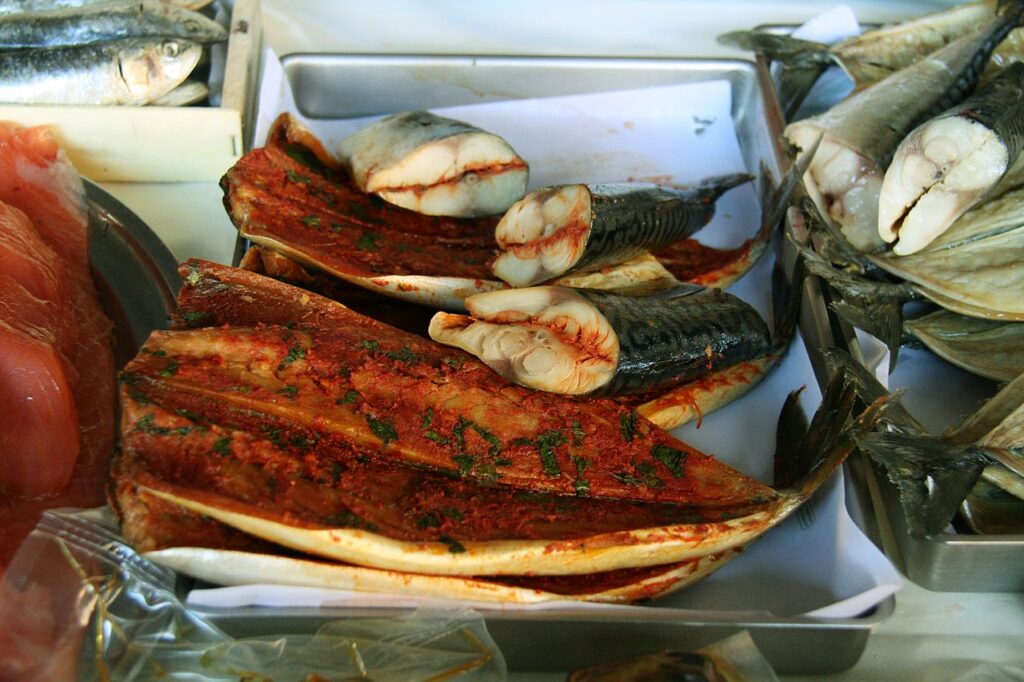Mackerel:
What is It?, history, cultivation, nutritional value, uses, recipes, and more...
The mackerel fish is a marine species that combines three very important characteristics: excellent taste, remarkable nutritional properties, and an affordable price. Currently, it is a marine resource of great importance in the Peruvian fishery and ranks third in significance among marine species of fishing relevance.
Índice
What is Mackerel?
The Mackerel, Scomber japonicus peruanus, is a neritic pelagic fish belonging to the Scombridae family. This fish is commonly found in oceanic waters with temperatures ranging from 15 to 23°C and a salinity range of 34.8 to 35.25 ups. Its distribution spans from Manta and the Galapagos Islands (Ecuador) to the southern region of Bahía Darwin (Chile) and up to 200 nautical miles off the coast. The species is most commonly found at depths of around 60 meters, although during events like El Niño, it has been located at depths of up to 240 meters.
This fish has a streamlined, fusiform body with two well-separated dorsal fins. The second dorsal and anal fins are followed by a series of smaller fins, usually numbering around 5, similar in shape and position. Its pectoral fin is small and situated high on the sides of the body, and it features a forked caudal fin with two small keels at the base of the caudal peduncle. The mackerel is covered in small scales across its body and has adipose eyelids that cover both the front and back of its eyes.
Its dorsal coloration is bottle green and adorned with a series of thick, wavy, vertical lines that form patterns. The flanks and belly are silver-yellow, with gray speckling, and the upper part of its head is translucent. It is often confused with the species Scomber scombrus, also known as Mackerel in countries like Spain.
It can reach up to 50 cm in length and is a gregarious fish that forms schools, especially in coastal areas, and undertakes long migrations.
History of Mackerel
The history of mackerel consumption dates back to prehistoric times. Remains found in several caves along the Mediterranean Sea belonging to coastal countries provide evidence of mackerel consumption during the Paleolithic, Epipaleolithic, Neolithic, and Bronze Ages. These discoveries include bone fragments resembling fishing harpoons or hooks, suggesting that the consumption of fish like mackerel was common and recurring.
There are recipes demonstrating its use from the 1st millennium BCE, but it was the Greeks in the 4th century BCE who began to commercialize products made from mackerel, which they referred to as “garo.” Among these, the most famous was Garum, a sauce that the Romans would later enthusiastically incorporate into their cuisine.
Mackerel was one of the most cherished fish for the Romans in preparing their favorite sauce, ‘garum,’ which was made by fermenting blue fish. The best garum was said to be prepared in Escombreras, giving the fish its Latin name ‘scomber.’
This sauce was widely used by the upper class to flavor their dishes, making it considerably expensive and traded in many cities.
During the 8th to 15th centuries, texts were written that discussed the therapeutic properties of mackerel-derived products, and its consumption gained prominence among the new fish recipes introduced to the Iberian Peninsula by Muslims.

Common Name of Mackerel
| Spanish | Caballa |
| English | Mackarel |
Scientific Name of Mackerel
Scomber japonicus peruanus
Taxonomy of Mackerel
| Kingdom | Plantae |
| Division | Magnoliophyta |
| Class | Magnoliopsida |
| Order | Caryophyllales |
| Family | Amaranthaceae |
| Subfamily | Chenopodioideae |
| Tribu | Chenopodieae |
| Gender | Chenopodium |
| Specie | Chenopodium quinoa |
Synonymy of Mackerel
Pneumatophorus peruanus Jordan y Hubbs, 1925 (aún en uso)
Etymology of Mackerel
From Late Latin “caballa” (meaning “mare”), and this has an uncertain origin.
Habitat of Mackerel
- Habitat
The mackerel is distributed in the Southeastern Pacific, ranging from Manta to the Galapagos Islands in Ecuador to the south of Bahía Darwin at 45º S in Chile. Along the coast of Peru, this fish can be found spanning over 100 nautical miles.
The concentration and distribution of its schools are influenced by the variation and interaction of water masses along our coastline. It can be observed that the mackerel approaches the coast during the summer or in warmer years (El Niño), and moves away during winter or colder years (La Niña).
Mackerel is a heterosexual species with no visible sexual dimorphism. It practices external fertilization and partial spawning. The average length of sexual maturity has been determined to be 29 cm fork length, and the average size at which first maturity begins is 26 cm.
Its primary spawning period occurs from late spring through summer, with the highest intensity from January to March. Its primary spawning area is located to the north of 07º10’ S latitude.
Geographic Distribution of Mackerel

Tumbes, Piura, Lambayeque, La libertad, Ancash, Lima, Ica, Arequipa, Moquegua, Tacna
Year-Round Availability of Mackerel
- Throughout the year, with a higher incidence between the months of October to February.
Varieties of Mackerel
-
Other Varieties
Several species with a significant similarity to mackerel belong to the same family: Scomber Scombrus, Estornino or Scomber japonicus, and Pintado Mackerel or Scomber australasicus.
Nutritional Value of Mackerel
Mackerel falls under the category of oily fish due to its high fat content, particularly omega-3 fatty acids. In fact, consuming a 100-gram portion of this fish provides only 10 grams of fat. Additionally, mackerel is rich in proteins (almost 20 grams in a 100-gram edible portion).
Mackerel is also abundant in vitamins, notably from the B group such as vitamin B1, B2, B3, B6, and B12. It also contains fat-soluble vitamins like A, D, and E. In terms of mineral content, it stands out for its levels of potassium, phosphorus, magnesium, iodine, and iron, although the latter is present in smaller amounts compared to meats.
Health Benefits of Mackerel
Mackerel stands out for its rich content of omega-3 fatty acids, which help prevent cardiovascular diseases. It also presents high values of vitamins from the A, B, and D groups.
Contraindications or Side Effects
Mackerel contains traces of mercury that can be harmful to pregnant women and young children, making its consumption in these groups inadvisable. Similarly, potential intoxications and allergies should be considered.
| 10 Porciones por Kilogramo | |
| Tamaño de porción | 100g |
| Cantidad por porción Calorías |
127 |
| Cantidad por 100g | |
| Energía | 533 kJ |
| Grasa Total | 4.9 g |
| Sodio | ● |
| Carbohidratos totales | 0.0 g |
| Carbohidratos disponibles | ● |
| Fibra Dietaria | ● |
| Proteínas | 19.5 g |
| Calcio | ● |
| Fósforo | ● |
| Zinc | ● |
| Hierro | ● |
| Potasio | ● |
| Agua | 73.8 g |
| Cenizas | 1.2 g |
| Vitamina A | ● |
| Tiamina (B1) | ● |
| Riboflavina (B2) | ● |
| Niacina (B3) | ● |
| Vitamina C | ● |
| Acido Fólico (B9) | ● |
| β-Caroteno | 0 μg |
| Fuente: Tablas peruanas de composición de alimentos – Centro Nacional de Alimentación y Nutrición – Ministerio de Salud – Perú | |
Derived Products and Ways of Consuming Mackerel
Uses of Mackerel
The primary use of mackerel lies in its incorporation into various dishes, capitalizing on its fantastic flavor and nutritional properties.
- Culinary
- Medicinal
Culinary Use of Mackerel
In cooking, mackerel offers us multiple possibilities. It can be grilled, baked, barbecued, pan-fried, broiled, used in stews, salads, and much more. Canning mackerel in escabeche or with different sauces and marinades is also quite common. In Peru, it is customary to enjoy it in ceviches, causas, tiraditos, among other dishes.
A notable characteristic of this fish is that it is not only a delicious and nutritious food but also an economical one, making it an excellent choice for any balanced diet. However, mackerel tends to deteriorate rather quickly, so when purchasing it, it's important to select pieces with a shinier skin and firmer, consistent flesh.
Medicinal Use of Mackerel
The consumption of mackerel, along with other oily fish, is recommended as it contributes to a decreased risk of heart and blood vessel diseases.
This species is rich in omega-3 fatty acids, which help reduce cholesterol and triglyceride levels in the blood, thereby reducing the risk of clot formation.
Likewise, mackerel is a good source of protein and contains various vitamins and minerals. Notably, its levels of vitamin B12 surpass those found in eggs and a significant portion of meats.



